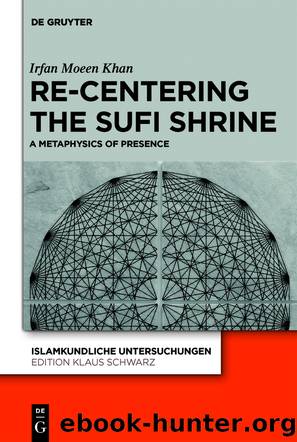Re-centering the Sufi Shrine by Irfan Moeen Khan

Author:Irfan Moeen Khan
Language: eng
Format: epub
Publisher: De Gruyter
Published: 2023-01-30T08:21:56.716000+00:00
Naḥnu aqarab kÄ« bansÄ« bajÄâÄ« man âarif nafsahu kÄ« kÅ«k sunÄâÄ«
Fathuma vajahu allahu kÄ« duhÅ«m machÄâÄ« darbar-i rasÅ«l allÄh
(Playing the flute/tune of âwe are closerâ (to you than your jugular vein), and the cry of âknow yourselfâ; a splendor in/of the court of Prophet: âwherever you look you will find the face of Godâ)
In this kÄfÄ« verse, Bulleh ShÄh juxtaposes first the QurâÄnic verse 50:16 with the playing of the flute (bansÄ«), which in the Indian context immediately suggests the flute of Krishna. The flute symbol is an important trope in Mawlana RumÄ«âs poetry, with which someone like Bulleh ShÄh would have been well acquainted. Nevertheless, the mention of the flute (bansÄ«) fits wholly within the context of the Indian religious landscape. After all, Bulleh ShÄh is celebrating the festival of Holi in the name of God, and the overlapping of the symbolism associated with Krishna with the QurâÄnic verse in this kÄfÄ« makes the appropriate connection. Moreover, as in the case of RumÄ«, the flute here can quite as quickly stand for the human body to symbolize the creation of Adam into whom God breathed His spirit/breath, or ruḥ (QurâÄn 15:29 and 38:72). In this manner, the use of the flute as a symbol lends itself to different interpretations, making it difficult in the context of Bulleh ShÄhâs milieu to prefer one interpretation over the other. Arguably, given Bulleh ShÄhâs wujÅ«dÄ« metaphysics, both readings are equally valid, and must be taken together to grasp the devotional effect of the kÄfÄ«. NahnÅ« aqarabu min ḥabli al-warÄ«di is the most robust QurâÄnic expression of the proximity of the Divine to the human soul, and it is incredibly potent because of the use of the corporeal image of the jugular vein.46 The verse depicting God as being closer to the human than his jugular vein is visualized in the kÄfÄ« as the playing of the flute by the Divine.47 This is then further complemented in the kÄfÄ« by a well-known, late ḥadÄ«th qudsÄ« âhe who knows himself knows his Lord.â48 This too has a broader significance in terms of its meaning in Indian mysticism. In this case, Bulleh ShÄh is building on the pre-existing Sufi tradition of emphasizing Divine intimacy through this QurâÄnic verse and then the ḥadÄ«th qudsÄ«âcompletely apart from the fact that these interpretations would be disputed or rejected by other traditionists and theologians.
The next line of the kÄfÄ« starts with another string of QurâÄnic words: âfathuma vajahu allahu,â which expresses the omnipresence of God in every direction.49 However, the full effect of the cosmology of âthe Face of Godâ is realized in the duhÅ«m machÄâÄ« rasÅ«l AllÄh, as manifested (tajjalÄ«) in the person of the Prophet, evident in/by the splendor of his court (darbar), which can also mean the tomb of the Prophet. Darbar of the Prophet also signifies Divine sovereignty or Kingship.
Download
This site does not store any files on its server. We only index and link to content provided by other sites. Please contact the content providers to delete copyright contents if any and email us, we'll remove relevant links or contents immediately.
Machine Learning at Scale with H2O by Gregory Keys | David Whiting(4172)
Never by Ken Follett(3787)
Fairy Tale by Stephen King(3216)
The Man Who Died Twice by Richard Osman(2995)
Reminders of Him: A Novel by Colleen Hoover(2943)
Will by Will Smith(2790)
Can't Hurt Me: Master Your Mind and Defy the Odds - Clean Edition by David Goggins(2225)
It Starts With Us (It Ends with Us #2) by Colleen Hoover(2194)
The Dawn of Everything: A New History of Humanity by David Graeber & David Wengrow(2122)
Friends, Lovers, and the Big Terrible Thing by Matthew Perry(2116)
The Becoming by Nora Roberts(2085)
The Stranger in the Lifeboat by Mitch Albom(2049)
Love on the Brain by Ali Hazelwood(1962)
New Morning Mercies: A Daily Gospel Devotional by Paul David Tripp(1875)
The Strength In Our Scars by Bianca Sparacino(1776)
HBR's 10 Must Reads 2022 by Harvard Business Review(1776)
A Short History of War by Jeremy Black(1758)
Go Tell the Bees That I Am Gone by Diana Gabaldon(1685)
515945210 by Unknown(1598)
